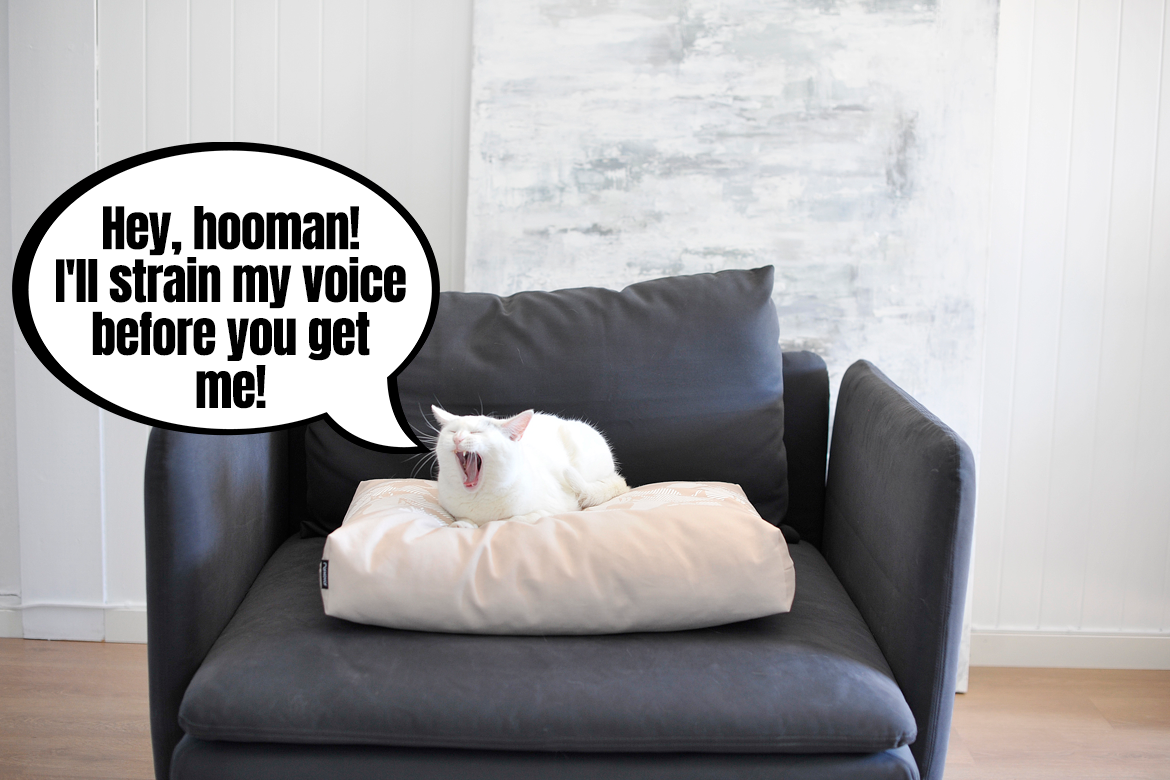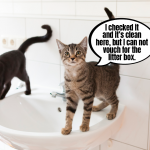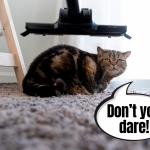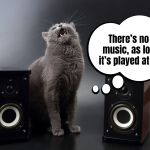What does your kitty want to say when they enter the room with their tail up in the air, when they crawl under your chair, when they meow, or when they lie down on the cat bed with their eyes turned towards you and blinking slowly? There are many ways a cat can communicate with us, hoomans, and understanding them can be tough. Even highly experienced behaviorists can have trouble interpreting what your furry friend has to say.
To understand a cat better, we have to consider all the signals that cats send us by their bodies: did you know, fabCat, that even the slightest movement of the tail or the ears, or the way how a cat looks at you can mean different things depending on the situation? Today we’ll try to learn how to read cats’ body language and go through the basics of cat communication that all fabCat Carers should be familiar with.
Cats meow only for hoomans
Meowing is a unique mechanism developed by cats to let them communicate with humans. Baby cats squeal to call their mother, but adult cats usually use other signals to communicate with each other. The typical meowing as we know it is a sound sent typically to the Carer: kitties use it to say they’re bored, ask you to fill their bowl, get your attention, or to communicate fear, pain, and all other states and emotions.
Living with cats, we learn to understand their unique language quite quickly. We know that short meows are their way of saying “hey” and the long, wailing sounds may mean something like “Hooman, I’m in pain” or “I’m scared, are you here?”. Your cat can meow little or not at all, but they can also be incredibly vocal and meow all the time and in response to everything, engaging this way in a conversation with you. With that in mind, it’s possible that your cat doesn’t try to tell you anything special: some individuals are just talkative.
Fun fact: There are cat breeds that are naturally more talkative, e.g. Siamese and Siberian cats. But there are also breeds of men of few words cats of few meows, e.g. the Scottish Folds. However, there’re always exceptions – individuals who get used to us reacting to their meowing can use it in everyday communication, even if they’re supposed to be generally silent.
Should meowing alarm us?
A cat’s meowing doesn’t necessarily have to mean problems requiring a visit to the vet or a behaviorist. They meow to talk to us, pawrents, and tell us what they think. If you know they do that everyday to wake you up at 5 am or when you come back home from work, there’s no reason to get worried.
What should you pay particular attention to? If your cat is not generally talkative and doesn’t meow in most situations but suddenly starts to give clear audible signals, there may be something wrong. Watch their behaviour and try to figure out the reason for the sudden ‘increase in volume’. Have you moved to a new place and your kitty feels uncomfortable in a new ‘territory’? Or maybe your cat meows every time they leave the litter box? Does your catto leave their bowl after just a few bites and meows loudly, as if shouting at you? If the meows seem disturbing and connected with particular actions or events, it’s always wise to consult the situation with a specialist.
Purring: when the kitty engine gets started
The sound of a cat purring is probably the most favorite sound of any cat Carer. For many years it has been believed that purring means the cat is happy: the engine inside the furry fellow starts every time they’re petted or brushed, or when the cat gently kneads a soft blanket – with obvious pleasure. Unfortunately, just like with meowing, it’s good to look into the purring sound a little bit closer and check if your kitty doesn’t use to calm themselves down. For cats, purring is a natural aid used to ease pain and discomfort.
Cats’ body language: communicating with the tail, ears, and whiskers
Meowing and purring are the basics, but they’re not the only signals a cat can send to communicate with us. Their behaviour, mood, and messages can be interpreted by considering the position and movement of their tail, ears, whiskers, and the entire body as a whole. It’s the mix of everything that enables behaviourists to interpret the cat body language and adapt their process in a way to help the cat achieve maximum happiness, comfort, and satisfaction. It would be great if we, cat Carers, were able to identify and respond accordingly to at least some of the most typical signals. So what are they then?
What does a cat’s tail say?
- if it’s erect or curved like a question mark shape, it means your cat is content and self confident;
- a tail pointed loosely downwards, relaxed is a sign of everything being normal: your cat is neither overly excited, nor angry or distressed; just living their normal, cat life;
- a moving and “wagging” tail means that the cat is annoyed: at first, it vibrates gently or moves slowly, but with time it goes faster and faster, giving a clear warning to the opponent or… You! Remember that in the case of cats – unlike in the case of dogs, a wagging tail doesn’t mean they’re playful and happy;
- bristled, stiff, and fully erect? With a tail in this position, the cat gives a signal of being scared but also ready to defend themselves or attack. The cat might even get entirely bristled, standing sideways to seem bigger and scarier to the opponent (so-called piloerection);
- a tail that is curled up, hidden under the belly may be a sign of paralysing fear, but also pain. If a cat flattens their ears, trying to seem visually smaller, it’s good to check if anything in the closest surroundings doesn’t stress the kitty out.
What does your cat tell you with their ears?
- ears raised up in neutral position: your cat is happy and relaxed,
- ears aimed to the front, in motion: the cat is clearly interested in something, investigating the surroundings,
- ears lowered, flattened: the cat is scared, terrified,
- ears close to the head, tense, almost invisible: the cat is angry, ready to attack.
How to read cats’ whiskers and mouth movement?
- whiskers relaxed, with no muscles tensed: the cat is happy and relaxed,
- whiskers pointed backwards, the mouth is tense: the cat is scared,
- whiskers hanging down or pointed backwards, with tensed muscles: the cat might be hiding pain,
- whiskers are tense, pointed forward, with tensed muscles: the cat is angry.
We have to remember that all those signals rarely happen in isolation and some of them can mean many different things, depending on how the rest of the body behaves. Look closely, always watch your cats’ behaviour, and consider their reactions to certain situations – it’s the easiest way to learn their non-vocal vocabulary!
How can a cat Carer talk with their cat?
By this point, we hope you know, our dear fabCat, what your cat may try to tell you with their behaviour and how they can communicate with you. But how can we, cat Carers, tell our cats what’s on our mind? How can we learn to speak the cat language and be able to communicate not only with our own furry friends, but with other cats met on the street or with our friends’ pets?
First of all: stay calm. Cats don’t like rapid actions, which is why loud noises, sudden sounds, and chaotic reactions can scare the kitty away. Always let them approach you first – don’t make the cat the first ‘person’ you approach as you enter your friend’s place.
If you want to pet a cat, let them initiate the touch – put out a finger towards them and point it softly in their direction, keeping a safe distance. Curious cats will sniff it first, as if they were touching noses with another cat, and later, as a sign of trust, they will start rubbing their cheek against your finger, showing you exactly how and where they want to be petted.
To inspire a cat’s trust, learn to say “I love you” in the kitty language. When a cat feels comfortable around you, they won’t have a problem exposing their belly to you or closing their eyes in your presence. And such calm, slow blinking is the cat version of “I love you” or, as some call it, a soft air kiss. Don’t stare at the cat intensely, but when you do make eye contact with them, try blinking softly and showing the cat they can trust you the same way as you trust them. If the kitty feels relaxed and at ease, they should return the blinks.
Cat-hooman communication: making friends with your kitty
By being together every day and strengthening the cat-hooman relationship through playtime and time spent with each other, you will be able to understand your kitty better – and vice versa. Learning the basic ways of how cats communicate in general as well as signals specific to your furry friend requires time and effort, but it’s definitely worth it.
And how do you, fabCats, talk with your kitties? Do you fist bump or headbutt each other every time you enter the house, or maybe you prefer making eye contact and letting your cat set the pace of your communication? Please let us know in the comments below and share your most interesting, unique ways of saying ‘Hello’ to both your own and newly met cattos.




